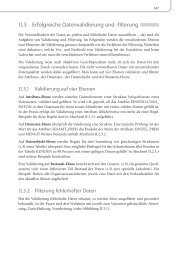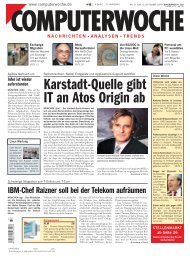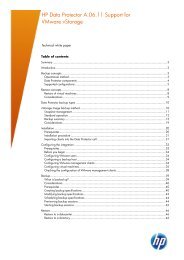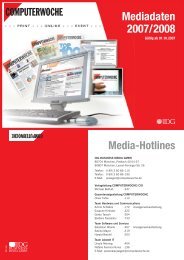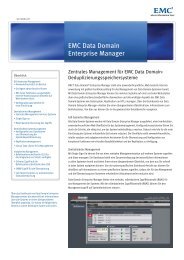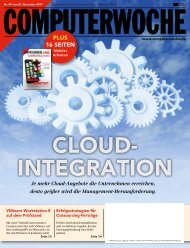The HP Business Intelligence Maturity Model: Describing the BI ...
The HP Business Intelligence Maturity Model: Describing the BI ...
The HP Business Intelligence Maturity Model: Describing the BI ...
Create successful ePaper yourself
Turn your PDF publications into a flip-book with our unique Google optimized e-Paper software.
Moving to Stage 3: In Stage 2, reports and<br />
analyses are usually delivered on a monthly or weekly<br />
basis, but evolving to Stage 3 requires a move to<br />
right-time information delivery. A company in Stage 2<br />
would, <strong>the</strong>refore, be wise to begin documenting <strong>the</strong><br />
information delivery needs of its <strong>BI</strong> consumers so<br />
that it is able to define exactly what right time means<br />
for each of its user groups. Documenting user needs<br />
also comes in handy for evolving and optimizing<br />
<strong>the</strong> types of reporting and analytical tools provided<br />
to <strong>BI</strong> consumers. Stage 3 also marks <strong>the</strong> beginning<br />
of more sophisticated data quality and governance<br />
efforts. Companies in Stage 2 should begin to identify<br />
those business departments or groups that have a<br />
commitment to taking ownership of <strong>the</strong>ir data and<br />
that could serve as ideal proving grounds for more<br />
sophisticated data quality and governance programs.<br />
Finally, a key characteristic of a Stage 3 company<br />
is <strong>the</strong> presence of a <strong>BI</strong> vision and roadmap. Stage 2<br />
enterprises should evaluate whe<strong>the</strong>r <strong>the</strong>y have <strong>the</strong><br />
in-house resources and know-how to develop <strong>the</strong>se<br />
assets, or if <strong>the</strong>y should seek assistance from an<br />
outside consulting partner.<br />
Stage 3: Integrating performance<br />
management and intelligence<br />
Companies in Stage 3 are beginning to achieve an<br />
integrated view of <strong>the</strong> subject- or vertical-oriented<br />
information solutions <strong>the</strong>y implemented in Stage 2.<br />
This integration enables increased business value<br />
through more complex metrics and analyses. For<br />
example, organizations in Stage 3 can begin to<br />
calculate metrics like customer profitability, which<br />
requires data from both <strong>the</strong> customer and financial<br />
domains. At this Stage, <strong>the</strong> business value of <strong>BI</strong><br />
begins to be realized. Metrics are defined, processes<br />
are in place and much of <strong>the</strong> thought processes that<br />
went into Stage 2 start to come toge<strong>the</strong>r into a set of<br />
assets and capabilities that directly target business<br />
improvement through broad-based use of <strong>BI</strong>.<br />
<strong>Business</strong> enablement in Stage 3: Once localized<br />
reporting needs have been satisfied in Stage 2, <strong>the</strong><br />
business drivers turn to a higher degree of alignment<br />
and integration, usually described by a linkage<br />
with a broader business performance management<br />
agenda within <strong>the</strong> organization. At this point, <strong>the</strong>re<br />
is a heightened focus on <strong>the</strong> value of analytics, often<br />
embedded within o<strong>the</strong>r systems or business workflows.<br />
Companies have implemented integrated reporting<br />
and are moving towards balanced scorecards<br />
and streamlined key performance indicators. <strong>BI</strong><br />
consumers are expanding to include more frontline<br />
employees, not just executives and management.<br />
<strong>The</strong> availability of data is also more consistent<br />
and instead of being defined by potential system<br />
constraints, data is now delivered when needed<br />
(at <strong>the</strong> right time) and pulled, cleansed and used<br />
according to <strong>the</strong> business needs.<br />
Information technology in Stage 3: Information<br />
integration across subject areas and across business<br />
unit solutions is key in this stage. Standalone data<br />
warehouses and marts are consolidated and an<br />
enterprise or centralized data warehouse is likely<br />
in <strong>the</strong> works. In Stage 3, companies are beginning<br />
early master data management efforts to achieve a<br />
single view of one or two key reference data domains,<br />
including customers, suppliers, and employees. Data<br />
quality and data governance efforts also become<br />
more important and more sophisticated at this stage.<br />
Specific business areas have taken ownership of <strong>the</strong>ir<br />
data and have identified data stewards.<br />
Strategy and program management in Stage 3:<br />
As business needs advance and information solutions<br />
reach higher levels of integration, management skills<br />
become critical to success. Stakeholder management<br />
(such as governance), resource management (such<br />
as outsourcing), and change management (such as<br />
competency centers) become key skills to facilitate<br />
heightened levels of integration. In Stage 3,<br />
organizations have evolved from <strong>BI</strong> project<br />
management to <strong>BI</strong> program management and<br />
have a <strong>BI</strong> vision and roadmap in place, business<br />
case discipline, a governance model, and a risk<br />
management methodology. <strong>BI</strong> competency centers<br />
(<strong>BI</strong>CCs) begin to evolve at this stage, along with<br />
early leverage of a three-tier delivery model to<br />
optimize costs and resources. At this point, C-level<br />
management is normally enthusiastically engaged<br />
in <strong>BI</strong>, as <strong>the</strong>y realize <strong>the</strong> quantitative impact on <strong>the</strong><br />
business, often resulting in cost savings.<br />
Moving to Stage 4: Empowering frontline users is a key<br />
focus of Stage 4. In Stage 3, executives, management,<br />
and a select group of power users likely comprise<br />
<strong>the</strong> vast majority of <strong>the</strong> organization’s <strong>BI</strong> user base.<br />
Expanding <strong>BI</strong> to “<strong>the</strong> masses” is a big requirement for<br />
moving to Stage 4. Companies in Stage 3 need to<br />
understand <strong>the</strong> requirements of a whole new group of<br />
users and <strong>the</strong> types of technologies (such as activity<br />
monitoring) that can meet <strong>the</strong>ir needs for operational<br />
information. Unstructured content also enters <strong>the</strong><br />
picture in Stage 4. Companies in Stage 3 should<br />
start to map out <strong>the</strong>ir unstructured information assets<br />
and understand how those assets can combine with<br />
structured data to enable more powerful analysis and<br />
guidance for both management and frontline users.<br />
5




